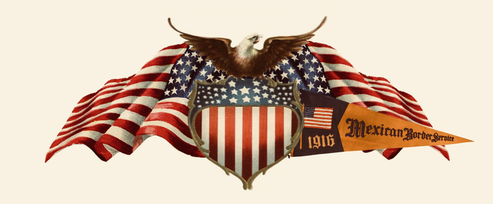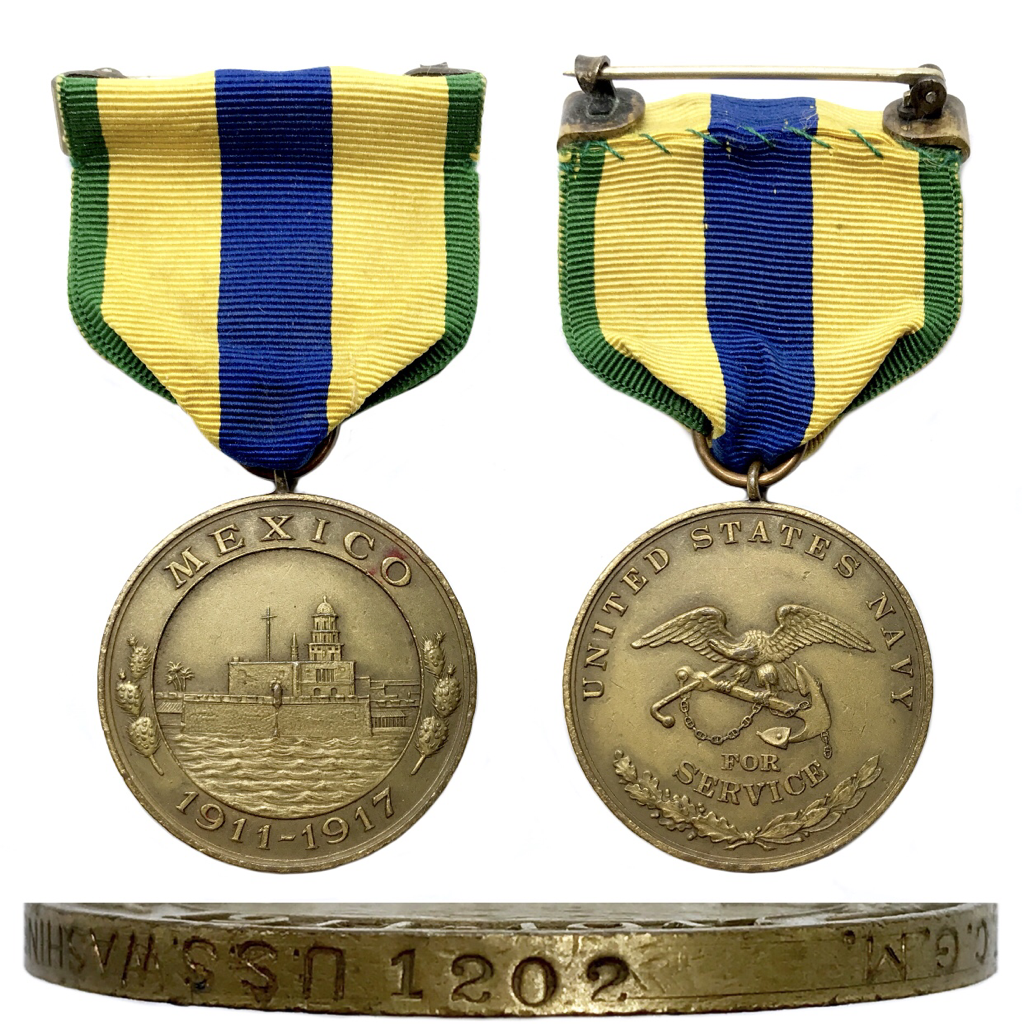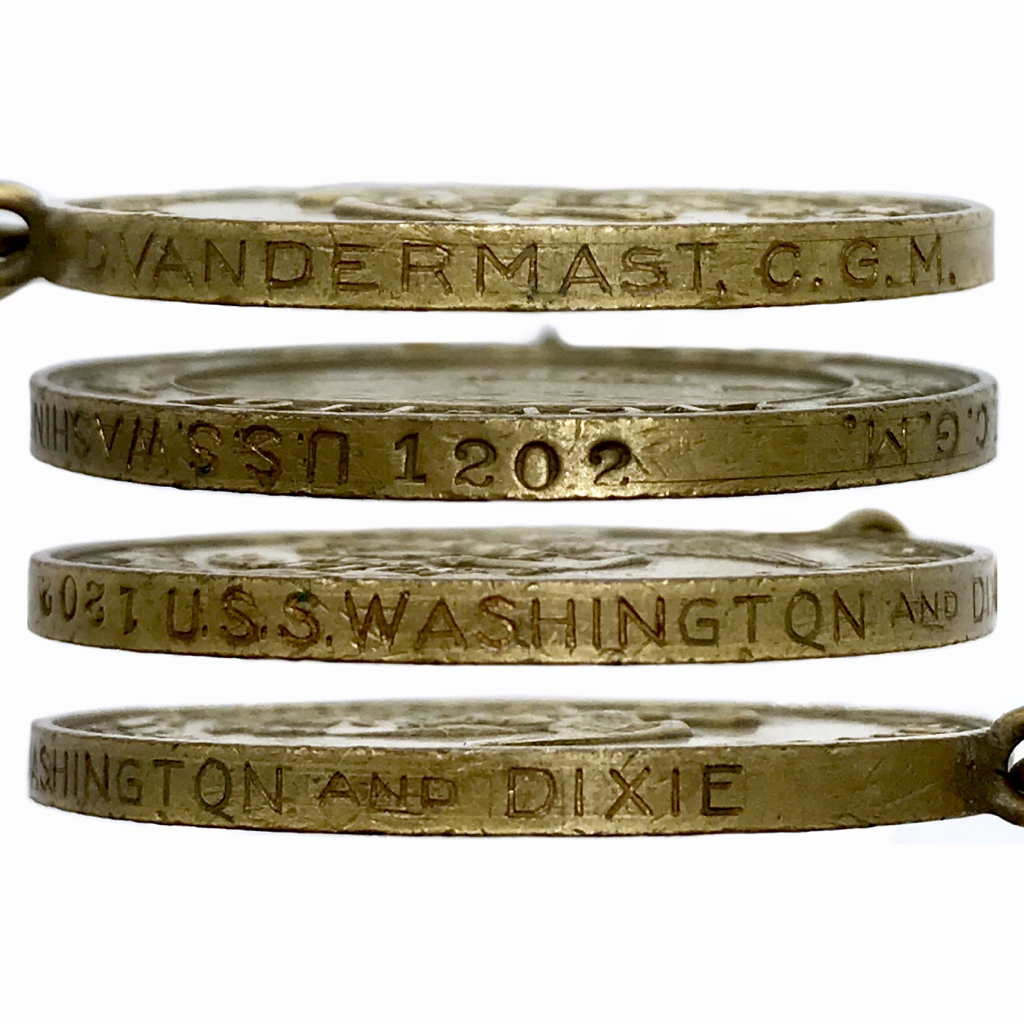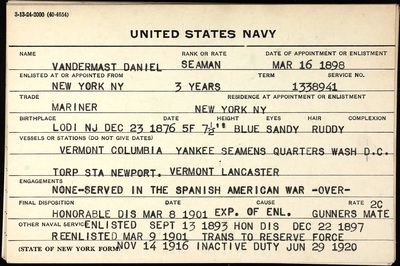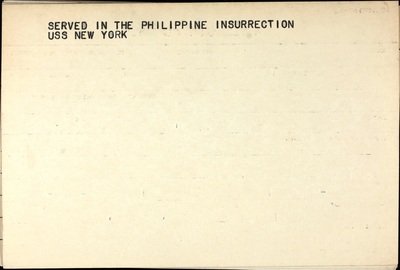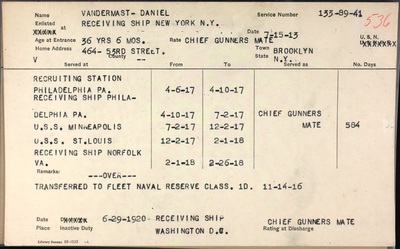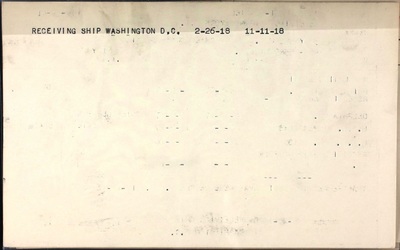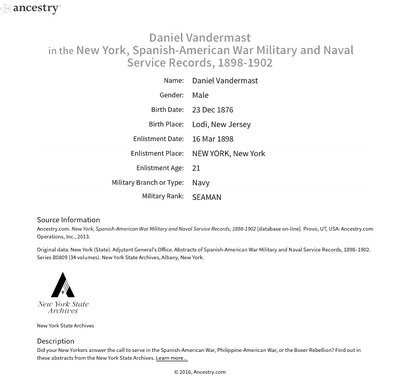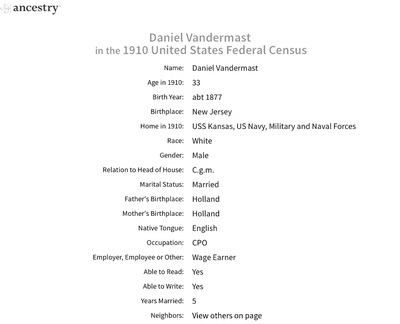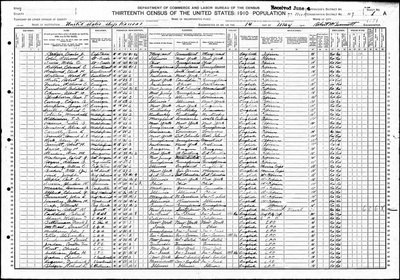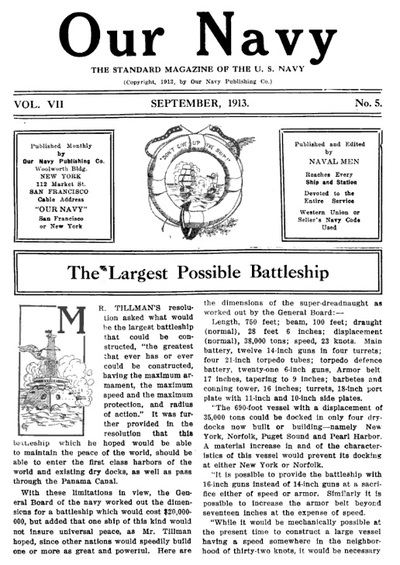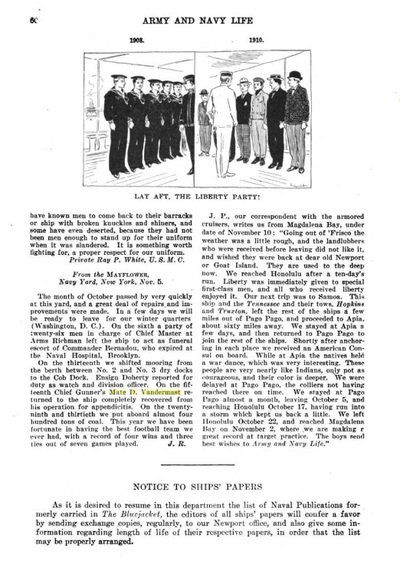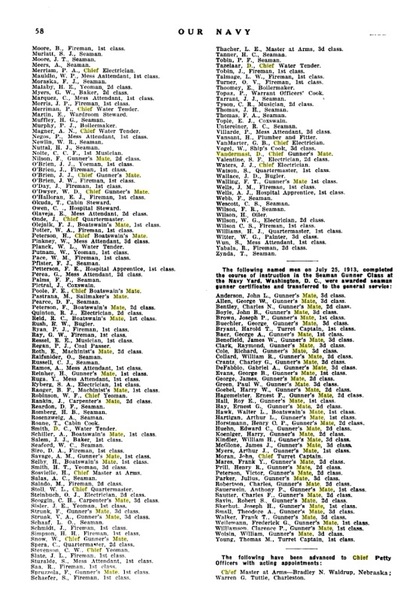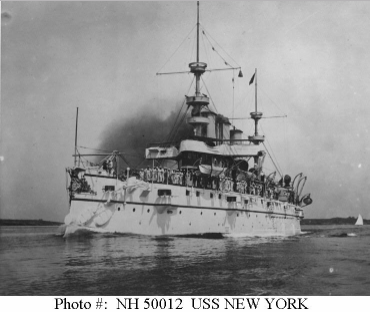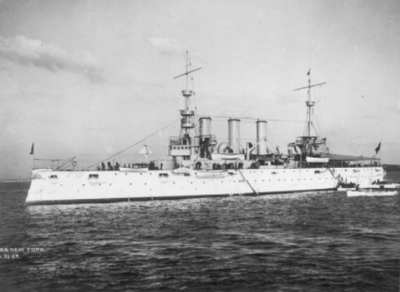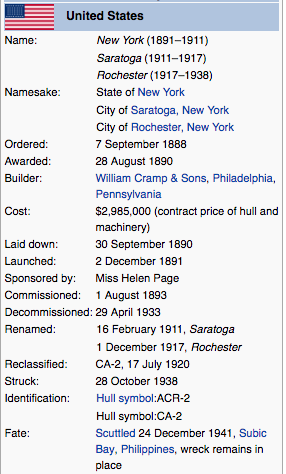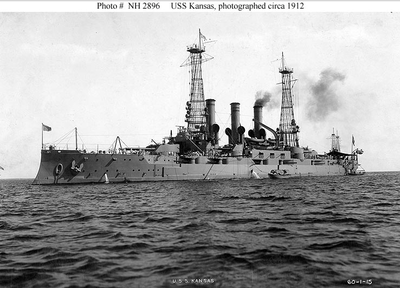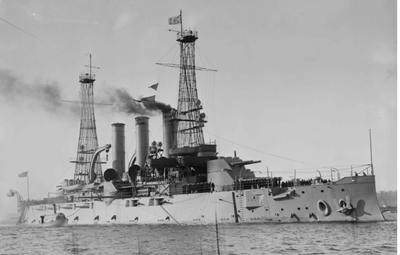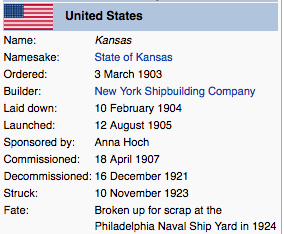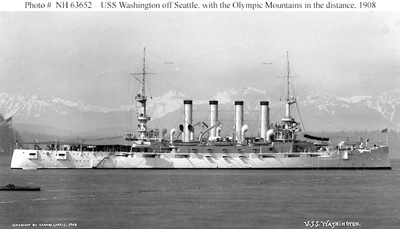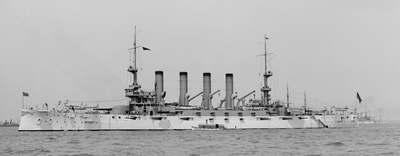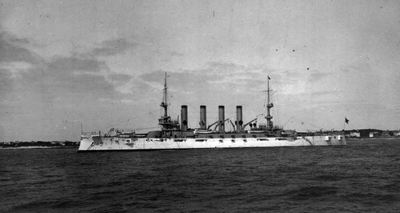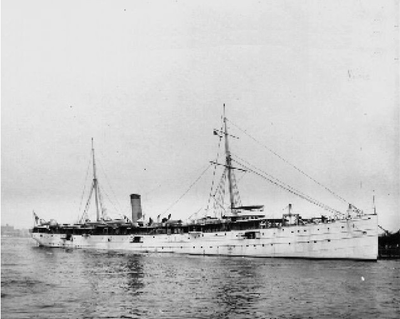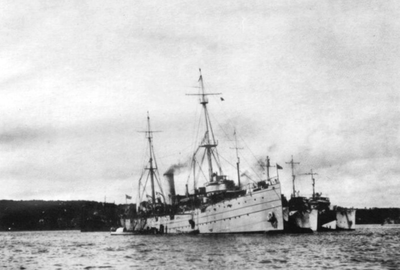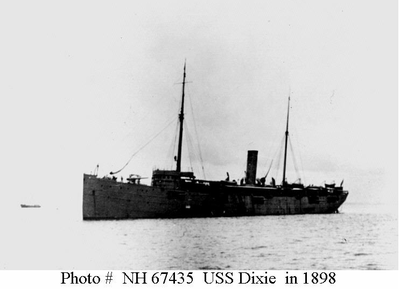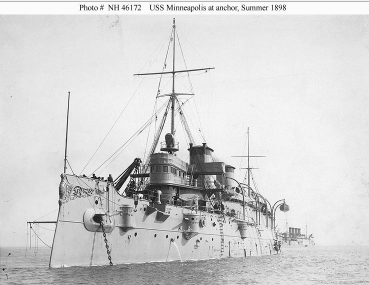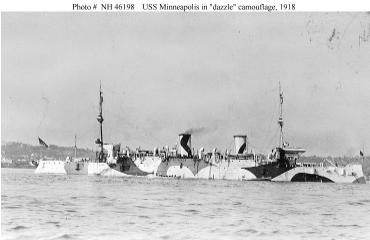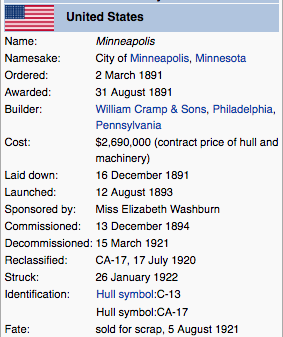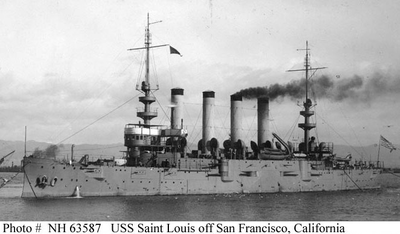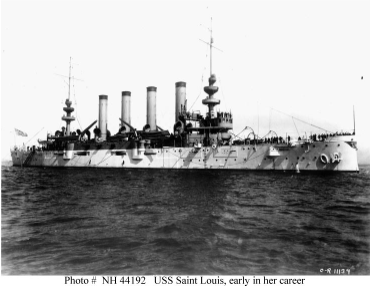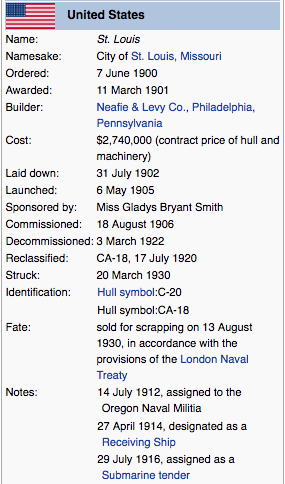BB&B 1911-1917 U.S. Navy Mexico Campaign Medal
#1202
"D. Vandermast U.S.S. Washington and Dixie"
"D. Vandermast U.S.S. Washington and Dixie"
Chief Gunners Mate Daniel Vandermast
United States Navy Cheif Gunners Mate Daniel Vandermast (Service #1338941) was born Dec. 26, 1876 in Lodi, New Jersey. He enlisted in the Navy Sept. 13, 1893 in New York, New York. Vandermast was honorably discharged Dec. 22, 1897. He then enlisted again March 16, 1898 during the Spanish American War. He served on the U.S.S. New York Armored Cruiser during the Philippine Insurrection.
The Gunners Mate was honorable discharged March 8, 1901, & he re-enlisted March 9, 1901. Records show Vandermast was on the U.S.S. Kansas Battleship in 1910. He then served on the U.S.S. Washington Armored Cruiser #11 & U.S.S. Dixie Auxiliary Cruiser. CGM Vandermast transferred to the U.S. Navy Reserve Force Nov. 14, 1916. During World War I, from July 2, 1917 to Dec. 2, 1917 he was stationed on the U.S.S. Minneapolis & the U.S.S. St. Louis from Dec. 2, 1917 to Feb. 1, 1918.
Cheif Gunners Mate was transferred to Inactive Duty June 29, 1920.
The Gunners Mate was honorable discharged March 8, 1901, & he re-enlisted March 9, 1901. Records show Vandermast was on the U.S.S. Kansas Battleship in 1910. He then served on the U.S.S. Washington Armored Cruiser #11 & U.S.S. Dixie Auxiliary Cruiser. CGM Vandermast transferred to the U.S. Navy Reserve Force Nov. 14, 1916. During World War I, from July 2, 1917 to Dec. 2, 1917 he was stationed on the U.S.S. Minneapolis & the U.S.S. St. Louis from Dec. 2, 1917 to Feb. 1, 1918.
Cheif Gunners Mate was transferred to Inactive Duty June 29, 1920.
U.S.S. New York
USS New York (ACR-2/CA-2) was the second United States Navy armored cruiser so designated; the first was the ill-fated Maine, which was soon redesignated a second-class battleship. The fourth Navy ship to be named in honor of the state of New York, she was later renamed Saratoga and then Rochester. With six 8-inch guns, she was the most heavily armed cruiser in the US Navy when commissioned.
She was laid down on 19 September 1890 by William Cramp and Sons, Philadelphia, launched on 2 December 1891, and sponsored by Miss Helen Clifford Page, the daughter of J. Seaver Page, the secretary of the Union League Club of New York. New York was commissioned 1 August 1893, Captain John Philip in command.
She was laid down on 19 September 1890 by William Cramp and Sons, Philadelphia, launched on 2 December 1891, and sponsored by Miss Helen Clifford Page, the daughter of J. Seaver Page, the secretary of the Union League Club of New York. New York was commissioned 1 August 1893, Captain John Philip in command.
U.S.S. Kansas
USS Kansas (BB-21) was a US Connecticut-class pre-dreadnought battleship, the fourth of six ships in the class. She was the second ship of the United States Navy named in honor of Kansas. The ship was launched in August 1905 and commissioned into the fleet in April 1907. Kansas was armed with a main battery of four 12-inch (300 mm) guns and was capable of a top speed of 18 kn (33 km/h; 21 mph).
Shortly after she entered service, Kansas joined the Great White Fleet for its circumnavigation of the globe in 1908–09. She made trips to Europe in 1910 and 1911 and after 1912, became involved in suppressing unrest in several Central American countries, including the United States occupation of Veracruz during the Mexican Revolution. After the United States entered World War I in April 1917, Kansas was employed as a training ship for new personnel. In September 1918, she began escorting convoys to Europe. After the war ended in November, she then began a series of trips to France to bring American soldiers home.
The ship's postwar career was short. She conducted training cruises for US Naval Academy cadets in 1920 and 1921, the first to the Pacific and the second to Europe. During this period she served briefly as the flagship of the 4th Battleship Division. After returning from the second cruise, Kansas was decommissioned and sold for scrap in August 1923 according to the terms of the Washington Naval Treaty.
Shortly after she entered service, Kansas joined the Great White Fleet for its circumnavigation of the globe in 1908–09. She made trips to Europe in 1910 and 1911 and after 1912, became involved in suppressing unrest in several Central American countries, including the United States occupation of Veracruz during the Mexican Revolution. After the United States entered World War I in April 1917, Kansas was employed as a training ship for new personnel. In September 1918, she began escorting convoys to Europe. After the war ended in November, she then began a series of trips to France to bring American soldiers home.
The ship's postwar career was short. She conducted training cruises for US Naval Academy cadets in 1920 and 1921, the first to the Pacific and the second to Europe. During this period she served briefly as the flagship of the 4th Battleship Division. After returning from the second cruise, Kansas was decommissioned and sold for scrap in August 1923 according to the terms of the Washington Naval Treaty.
U.S.S. Washington
The seventh USS Washington (ACR-11/CA-11/IX-39), also referred to as "Armored Cruiser No. 11", and later renamed Seattle and reclassified CA-11and IX-39, was a United States Navy Tennessee-class armored cruiser. She was laid down on 23 September 1903 at Camden, New Jersey, by the New York Shipbuilding Corporation, launched on 18 March 1905, sponsored by Miss Helen Stewart Wilson, daughter of United States Senator John L. Wilson of Washington state, and commissioned at the Philadelphia Navy Yard on 7 August 1906, Captain James D. Adams in command.
After returning to the Fleet and participating in maneuvers in Guantánamo Bay, Cuba, in late January and early February 1912, Washington steamed back to the Norfolk Navy Yard where, between 13 and 19 February, she underwent special preparations to embark the Secretary of State and his party. The armored cruiser then shifted to Key West where she embarked the Secretary on 23 February. In the ensuing weeks, Washington carried Philander C. Knox and his guests to such ports as Colón, Panama; Port Limón, Costa Rica; Puerto Barrios, Guatemala; La Guaira, Venezuela; Santo Domingo; St. Thomas; Puerto Cabello, Venezuela; San Juan; Port-au-Prince; Guantánamo Bay; Kingston, Jamaica; and Havana, before disembarking her distinguished guests at Piney Point, Maryland, on 16 April.
The high point of the spring of 1912 for Washington was her service as temporary flagship for the Commander in Chief, Atlantic Fleet, while she was at the Philadelphia Navy Yard from 19 April – 3 May. The warship subsequently paused at New York from 9–12 May and at the Portsmouth Navy Yard for an inspection by the Board of Inspection and Survey for ships before she conducted maneuvers out of Provincetown and Newport and then received Rear Admiral Hugo Osterhaus — the Commander in Chief, Atlantic Fleet – aboard on 26 May. After shifting to Hampton Roads, Washington embarked a detachment of additional Marines on 27 May, took on stores; and set out that day for Key West. There, she awaited further orders from 30 May – 10 June, while President Taft concentrated a strong naval force there to prepare for possible action which might be required by internal problems in Cuba.
In the late spring and early summer, a rebellion on that Caribbean island occasioned a show of force by the United States. Washington accordingly departed Key West on 10 June and arrived at Havana later that day. She remained there on "duty in connection with the Cuban rebellion" until 1 July, when she shifted to Guantánamo. The rebellion on the island was put down by the Cuban Government, resulting in the withdrawal of the American naval and marine representation there. Accordingly, Washington sailed to Hampton Roads, where she discharged her marines and equipment and went into "first reserve" at the Portsmouth Navy Yard on 9 July.
Washington remained inactive until 8 October, when she sailed for New York to participate in the Naval Review held there from 10–15 October and then resumed her reserve status at Portsmouth on 17 October. Shifted subsequently from Portsmouth to the New York Navy Yard – via President Roads, Massachusetts, and Tompkinsville, Staten Island — Washington was assigned duty as receiving ship at the navy yard on 20 July.
The armored cruiser was placed in commission again on 23 April 1914, Captain Edward W. Eberle in command. Later that spring, the armored cruiser took aboard drafts of men from Norfolk and Port Royal, South Carolina on 30 April and 2 May; touched at Key West, and proceeded to Santo Domingo
After returning to the Fleet and participating in maneuvers in Guantánamo Bay, Cuba, in late January and early February 1912, Washington steamed back to the Norfolk Navy Yard where, between 13 and 19 February, she underwent special preparations to embark the Secretary of State and his party. The armored cruiser then shifted to Key West where she embarked the Secretary on 23 February. In the ensuing weeks, Washington carried Philander C. Knox and his guests to such ports as Colón, Panama; Port Limón, Costa Rica; Puerto Barrios, Guatemala; La Guaira, Venezuela; Santo Domingo; St. Thomas; Puerto Cabello, Venezuela; San Juan; Port-au-Prince; Guantánamo Bay; Kingston, Jamaica; and Havana, before disembarking her distinguished guests at Piney Point, Maryland, on 16 April.
The high point of the spring of 1912 for Washington was her service as temporary flagship for the Commander in Chief, Atlantic Fleet, while she was at the Philadelphia Navy Yard from 19 April – 3 May. The warship subsequently paused at New York from 9–12 May and at the Portsmouth Navy Yard for an inspection by the Board of Inspection and Survey for ships before she conducted maneuvers out of Provincetown and Newport and then received Rear Admiral Hugo Osterhaus — the Commander in Chief, Atlantic Fleet – aboard on 26 May. After shifting to Hampton Roads, Washington embarked a detachment of additional Marines on 27 May, took on stores; and set out that day for Key West. There, she awaited further orders from 30 May – 10 June, while President Taft concentrated a strong naval force there to prepare for possible action which might be required by internal problems in Cuba.
In the late spring and early summer, a rebellion on that Caribbean island occasioned a show of force by the United States. Washington accordingly departed Key West on 10 June and arrived at Havana later that day. She remained there on "duty in connection with the Cuban rebellion" until 1 July, when she shifted to Guantánamo. The rebellion on the island was put down by the Cuban Government, resulting in the withdrawal of the American naval and marine representation there. Accordingly, Washington sailed to Hampton Roads, where she discharged her marines and equipment and went into "first reserve" at the Portsmouth Navy Yard on 9 July.
Washington remained inactive until 8 October, when she sailed for New York to participate in the Naval Review held there from 10–15 October and then resumed her reserve status at Portsmouth on 17 October. Shifted subsequently from Portsmouth to the New York Navy Yard – via President Roads, Massachusetts, and Tompkinsville, Staten Island — Washington was assigned duty as receiving ship at the navy yard on 20 July.
The armored cruiser was placed in commission again on 23 April 1914, Captain Edward W. Eberle in command. Later that spring, the armored cruiser took aboard drafts of men from Norfolk and Port Royal, South Carolina on 30 April and 2 May; touched at Key West, and proceeded to Santo Domingo
U.S.S. Dixie
The first USS Dixie (later AD-1) was a United States Navy auxiliary cruiser and later a destroyer tender. The Dixiewas the first ship of the United States Navy to have this name.
She was built as the steam brig El Rio in 1893 by Newport News Shipbuilding and Dry Dock Co., Newport News, Virginia for the Southern Pacific Railroad's Morgan Line. El Rio was purchased by the Navy 15 April 1898, converted to an auxiliary cruiser by her builder, and commissioned 19 April 1898, Commander Charles Henry Davis, Jr. in command.
She remained out of commission until 2 February 1909 when she was assigned as tender to Atlantic Torpedo Flotilla and Destroyer Squadron, Atlantic Fleet. She cruised on the east coast, in the Caribbean, and in the Gulf of Mexico in this service. In addition to her tender duty, she towed submarines; transported Marines and crews for other ships; carried the Nicaraguan expeditionary force to Colón, C.Z., and took part in the operations off Mexico during April and May 1914, transporting supplies and refugees from 1914 to 1915. She returned to Philadelphia 16 December 1915.
From 18 June 1916 to 6 May 1917, Dixie served as tender for Destroyer Force, Atlantic Fleet; engaged in gunnery exercises with destroyers and maneuvers with the fleet; delivered stores and mail; transported refugees from Mexico to Galveston, Texas, and served as tender to Squadron 4, Patrol Force, at Key West.
With American entry into World War I, Dixie departed Philadelphia 31 May 1917 to join U.S. naval forces operating in European waters. Arriving at Queenstown, Ireland, 12 June, she served as tender for American destroyers based at that port until 15 December 1918, except for a period of similar duty at Berehaven (21 June-27 August 1917). Returning to Philadelphia 22 February 1919, Dixie served as tender to destroyer flotillas operating on the east coast, and in the Caribbean. On 24 February 1919, Dixie ran aground shortly after putting out of Kingston, Jamaica. She was pulled free by USS Bridgeport, and was able to continue on with the destroyer force to Guantánamo Bay.
She was built as the steam brig El Rio in 1893 by Newport News Shipbuilding and Dry Dock Co., Newport News, Virginia for the Southern Pacific Railroad's Morgan Line. El Rio was purchased by the Navy 15 April 1898, converted to an auxiliary cruiser by her builder, and commissioned 19 April 1898, Commander Charles Henry Davis, Jr. in command.
She remained out of commission until 2 February 1909 when she was assigned as tender to Atlantic Torpedo Flotilla and Destroyer Squadron, Atlantic Fleet. She cruised on the east coast, in the Caribbean, and in the Gulf of Mexico in this service. In addition to her tender duty, she towed submarines; transported Marines and crews for other ships; carried the Nicaraguan expeditionary force to Colón, C.Z., and took part in the operations off Mexico during April and May 1914, transporting supplies and refugees from 1914 to 1915. She returned to Philadelphia 16 December 1915.
From 18 June 1916 to 6 May 1917, Dixie served as tender for Destroyer Force, Atlantic Fleet; engaged in gunnery exercises with destroyers and maneuvers with the fleet; delivered stores and mail; transported refugees from Mexico to Galveston, Texas, and served as tender to Squadron 4, Patrol Force, at Key West.
With American entry into World War I, Dixie departed Philadelphia 31 May 1917 to join U.S. naval forces operating in European waters. Arriving at Queenstown, Ireland, 12 June, she served as tender for American destroyers based at that port until 15 December 1918, except for a period of similar duty at Berehaven (21 June-27 August 1917). Returning to Philadelphia 22 February 1919, Dixie served as tender to destroyer flotillas operating on the east coast, and in the Caribbean. On 24 February 1919, Dixie ran aground shortly after putting out of Kingston, Jamaica. She was pulled free by USS Bridgeport, and was able to continue on with the destroyer force to Guantánamo Bay.
U.S.S. Minneapolis
The first USS Minneapolis (CA-17, ex-C-13) was a United States Navy Columbia-class protected cruiser. She was named for the city of Minneapolis, Minnesota.
Minneapolis was laid down 16 December 1891 by William Cramp & Sons, Philadelphia; launched 12 August 1893, sponsored by Miss Elizabeth Washburn, daughter of Senator William D. Washburn of Minnesota; and commissioned at Philadelphia, 13 December 1894, Captain George H. Wadleigh, in command.
Recommissioned 2 July 1917, Minneapolis got underway from Philadelphia 15 September for Hampton Roads, and departed that base 26 October for Colon, Panama Canal Zone, where she joined British transports Arawa and Corinthia. The vessels sailed from Colon 6 November and steamed by way of Hampton Roads to Halifax, Nova Scotia. The cruiser continued to operate along the Atlantic coast until assigned to transatlantic convoy duty 24 February 1918. During the next 8 months, she made four escort voyages, departing New York and sailing to ocean rendezvous where the convoys were turned over to British destroyers. On her last voyage, she departed New York on 9 October as escort for a convoy to Sydney, Nova Scotia, and returned to New York, 19 October.
Minneapolis was laid down 16 December 1891 by William Cramp & Sons, Philadelphia; launched 12 August 1893, sponsored by Miss Elizabeth Washburn, daughter of Senator William D. Washburn of Minnesota; and commissioned at Philadelphia, 13 December 1894, Captain George H. Wadleigh, in command.
Recommissioned 2 July 1917, Minneapolis got underway from Philadelphia 15 September for Hampton Roads, and departed that base 26 October for Colon, Panama Canal Zone, where she joined British transports Arawa and Corinthia. The vessels sailed from Colon 6 November and steamed by way of Hampton Roads to Halifax, Nova Scotia. The cruiser continued to operate along the Atlantic coast until assigned to transatlantic convoy duty 24 February 1918. During the next 8 months, she made four escort voyages, departing New York and sailing to ocean rendezvous where the convoys were turned over to British destroyers. On her last voyage, she departed New York on 9 October as escort for a convoy to Sydney, Nova Scotia, and returned to New York, 19 October.
U.S.S. St. Louis
The fourth USS St. Louis (C-20/CA-18), was the lead ship of her class of protected cruisers in the United States Navy. St. Louis was launched on 6 May 1905 by the Neafie & Levy Company, of Philadelphia, Pennsylvania. It was sponsored by Miss Gladys Bryant Smith and commissioned on 18 August 1906 with Captain Nathaniel R. Usher in command.
Placed in reduced commission on 6 April 1917, as the United States entered World War I, St. Louis departed Honolulu on 9 April to join the cruiser force engaged in escorting convoys bound for Europe. Calling first at San Diego, she took on board 517 National Naval Volunteers and apprentice seamen to bring her war complement to 823 officers and men. On 20 April, she was placed in full commission. A month later, she arrived in the Panama Canal Zone and embarked the 7th, 17th, 20th, 43d, 51st and 55th companies of Marines. She transported them to Santiago de Cuba and then sailed for Philadelphia, arriving on 29 May 1917.
St. Louis's first convoy duty began on 17 June 1917 when she departed New York in escort of Group 4, American Expeditionary Force. Returning to Boston for repairs on 19 July 1917, she had completed six additional voyages, escorting convoys bound from New York for ports in Britain and France by the end of the war.
Together with the USS Huntington she left Halifax on 30 October 1917 carrying members of a high-level U.S. Commission to confer with the European Allies. Escorted by USS Balch and other British and American vessels she arrived in Plymouth on the evening of 7 November.
Placed in reduced commission on 6 April 1917, as the United States entered World War I, St. Louis departed Honolulu on 9 April to join the cruiser force engaged in escorting convoys bound for Europe. Calling first at San Diego, she took on board 517 National Naval Volunteers and apprentice seamen to bring her war complement to 823 officers and men. On 20 April, she was placed in full commission. A month later, she arrived in the Panama Canal Zone and embarked the 7th, 17th, 20th, 43d, 51st and 55th companies of Marines. She transported them to Santiago de Cuba and then sailed for Philadelphia, arriving on 29 May 1917.
St. Louis's first convoy duty began on 17 June 1917 when she departed New York in escort of Group 4, American Expeditionary Force. Returning to Boston for repairs on 19 July 1917, she had completed six additional voyages, escorting convoys bound from New York for ports in Britain and France by the end of the war.
Together with the USS Huntington she left Halifax on 30 October 1917 carrying members of a high-level U.S. Commission to confer with the European Allies. Escorted by USS Balch and other British and American vessels she arrived in Plymouth on the evening of 7 November.
